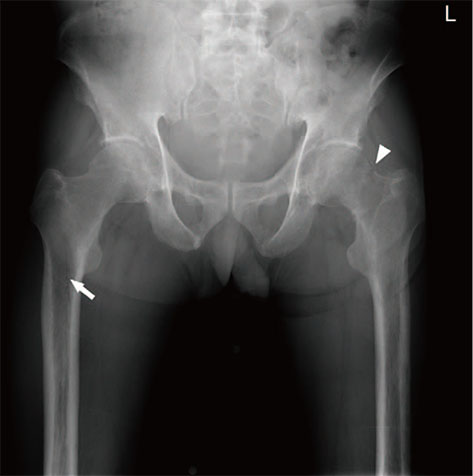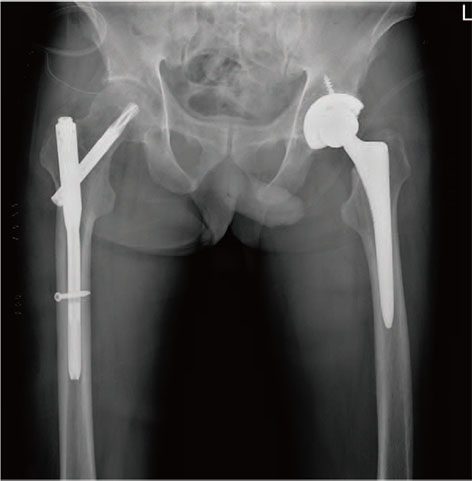Hip Pelvis.
2018 Jun;30(2):109-114. 10.5371/hp.2018.30.2.109.
An Uncommon Case of Bilateral Pathologic Hip Fractures: Antiviral Drug-induced Osteomalacia in a Patient with Hepatitis B
- Affiliations
-
- 1Department of Orthopaedic Surgery, Pusan National University Hospital, Pusan National University School of Medicine, Busan, Korea.
- 2Department of Orthopaedic Surgery, Medical Research Institute, Pusan National University Yangsan Hospital, Pusan National University School of Medicine, Yangsan, Korea. dreami3e5t@pusan.ac.kr
- KMID: 2412692
- DOI: http://doi.org/10.5371/hp.2018.30.2.109
Abstract
- The long-term use of adefovir and tenofovir-antiviral medications commonly used to treat chronic hepatitis B-can be associated with proximal renal tubular dysfunction resulting in significant hypophosphatemic osteomalacia. However, there have been few reports about pathological fractures requiring surgical stabilization in cases of antiviral drug-induced hypophosphatemic osteomalacia. We present the case of a 51-year-old man who sustained bilateral pathological hip fractures associated with antiviral drug-induced hypophosphatemic osteomalacia. To treat a lamivudine-resistant hepatitis-B viral infection, the patient received adefovir for 7 years followed by tenofovir for the subsequent 3 years. He had suffered from polyarthralgia and generalized weakness for 2 years prior to presentation at our clinic. Misdiagnosis and inadequate management of his condition accelerated weakness of the bone matrix and ultimately induced pathological fractures. The patient was managed via cementless total hip arthroplasty on the left hip and internal fixation on the right hip. This case highlights that orthopaedic surgeons should consider the possibility of hypophosphatemic osteomalacia if patients receiving antiviral drugs complain of polyarthralgia and generalized weakness.
MeSH Terms
Figure
Reference
-
1. Koenig KF, Kalbermatter S, Menter T, Graber P, Kiss D. Recurrent bone fractures due to tenofovir-induced renal phosphate wasting. Scand J Infect Dis. 2014; 46:221–224.
Article2. Tanaka M, Setoguchi T, Ishidou Y, et al. Pathological femoral fractures due to osteomalacia associated with adefovir dipivoxil treatment for hepatitis B: a case report. Diagn Pathol. 2012; 7:108.
Article3. Jung YK, Yeon JE, Choi JH, et al. Fanconi's syndrome associated with prolonged adefovir dipivoxil therapy in a hepatitis B virus patient. Gut Liver. 2010; 4:389–393.
Article4. Kim du H, Sung DH, Min YK. Hypophosphatemic osteomalacia induced by low-dose adefovir therapy: focus on manifestations in the skeletal system and literature review. J Bone Miner Metab. 2013; 31:240–246.
Article5. Terasaka T, Ueta E, Ebara H, et al. Long-term observation of osteomalacia caused by adefovir-induced Fanconi's syndrome. Acta Med Okayama. 2014; 68:53–56.6. Jeong HJ, Lee JM, Lee TH, et al. Two cases of hypophosphatemic osteomalacia after long-term low dose adefovir therapy in chronic hepatitis B and literature review. J Bone Metab. 2014; 21:76–83.
Article7. Sit YK, Lui TH. Corrective osteotomy in femoral non-union in drug-induced hypophosphataemic osteomalacia. BMJ Case Rep. 2014; 2014:bcr2013201269.
Article8. Tanji N, Tanji K, Kambham N, Markowitz GS, Bell A, D'agati VD. Adefovir nephrotoxicity: possible role of mitochondrial DNA depletion. Hum Pathol. 2001; 32:734–740.
Article9. Reginato AJ, Coquia JA. Musculoskeletal manifestations of osteomalacia and rickets. Best Pract Res Clin Rheumatol. 2003; 17:1063–1080.
Article10. Garden RS. Stability and union in subcapital fractures of the femur. J Bone Joint Surg Br. 1964; 46:630–647.
Article11. Le May , Blunt JW Jr. A factor determining the location of pseudofractures in osteomalacia. J Clin Invest. 1949; 28:521–525.
Article12. Steinbach HL, Kolb FO, Gilfillan R. A mechanism of the production of pseudofractures in osteomalacia (Milkman's syndrome). Radiology. 1954; 62:388–395.
Article13. Lee C, Lashari S. Pseudofracture of the neck of femur secondary to osteomalacia. J Bone Joint Surg Br. 2007; 89:956–958.
Article14. Palermo A, Strollo R, Papalia R, et al. Severe hypophosphatemic osteomalacia secondary to Fanconi syndrome due to adefovir: a case report. Endocr Pract. 2014; 20:e246–e249.
Article
- Full Text Links
- Actions
-
Cited
- CITED
-
- Close
- Share
- Similar articles
-
- Three Cases of Osteomalacia with Fractures Induced by Adefovir in Chronic Hepatitis B
- Pathologic Femoral Neck Fracture Due to Fanconi Syndrome Induced by Adefovir Dipivoxil Therapy for Hepatitis B
- Bone Scintigraphy and Tenofovir-Induced Osteomalacia in Chronic Hepatitis B
- Atraumatic Bilateral Fracture of the Femoral Neck in Young Male Patient with Suspected Osteomalacia
- Oncogenic Osteomalacia with Multiple Insufficiency Fractures: A Case Report





